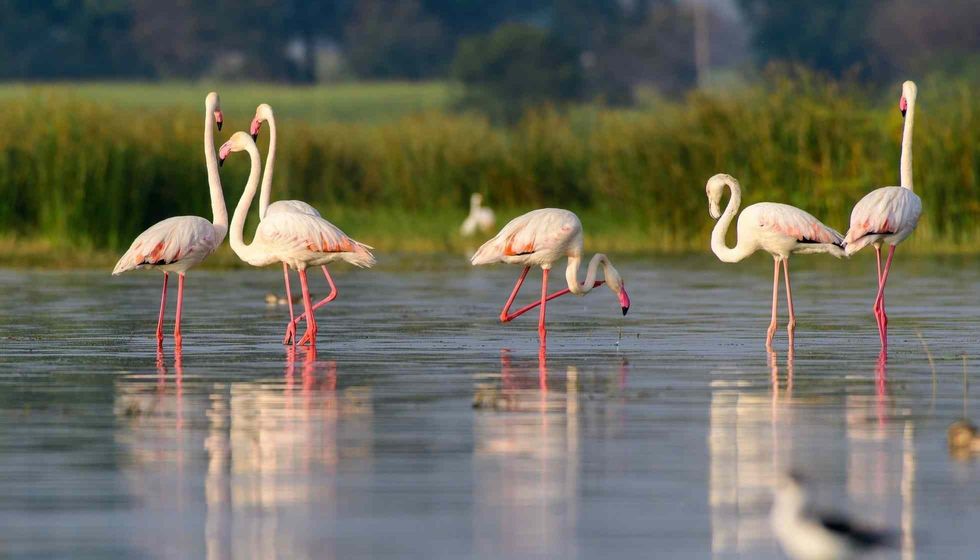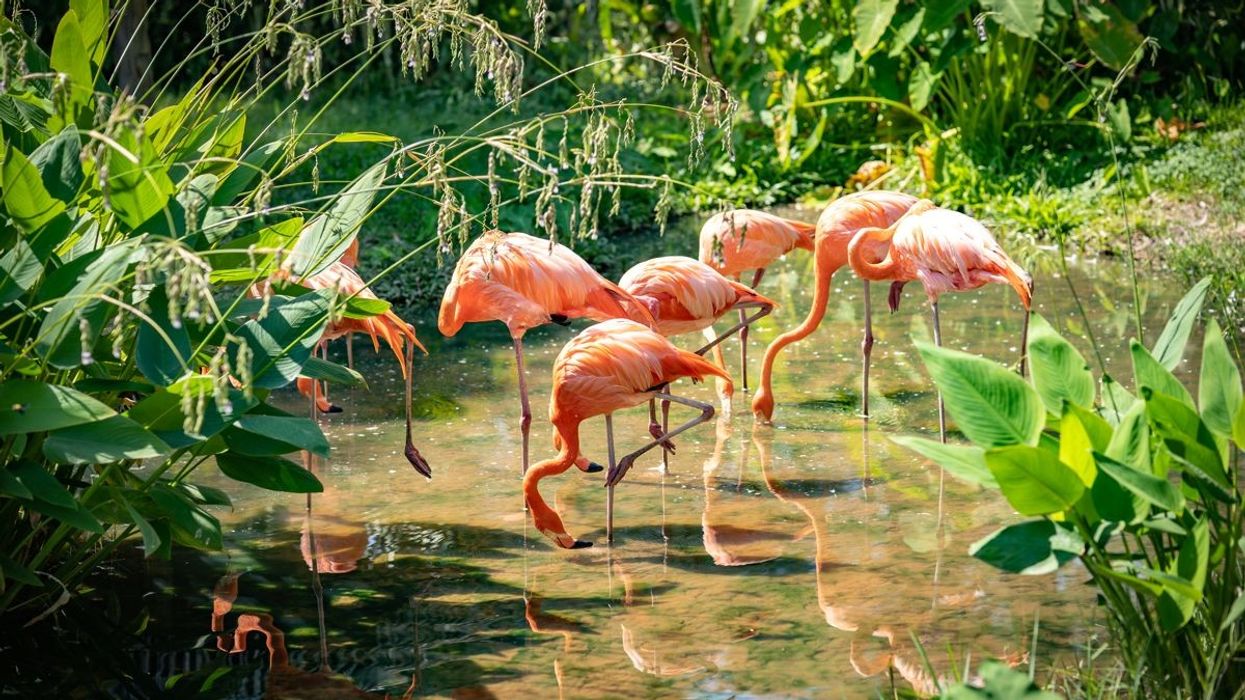The greater flamingo (Phoenicopterus roseus), which is known for its pink plumage, is considered to be the most widespread species of the family of flamingos. These large birds with whitish-pink plumage can stand in thick mud where they find plenty of food to feed on.
They have a big elongated bill and long pinkish legs. Many of the greater flamingos in Asia and Africa have been recorded to move towards warmer climates from cold climates.
They move in a flock consisting of several hundreds of other flamingos. The greater flamingo predators are generally crows, gulls, and raptors who hunt eggs and chicks.
The greater flamingo bird is one of the most popular species, known for its beautiful color. During the breeding season, flamingos exhibit different behaviors to form courtship.
If you are fascinated by greater flamingos, then you may want to read the following amazing facts about them. If you want to learn more about different animals, you can read up on the bee-eater and the umbrellabird.
Greater Flamingo Interesting Facts
What type of animal is a greater flamingo?
This species of flamingo can be found on the Indian subcontinent among many other places.
What class of animal does a greater flamingo belong to?
Flamingos belong to the Aves class of animals that exist in regions of Africa, the Middle East, and southern Europe.
How many greater flamingos are there in the world?
The exact population of the greater flamingo (Phoenicopterus roseus) present in the world is unknown. However, they are not endangered and have been listed as Least Concern by the International Union for Conservation of Nature (IUCN).
Where does a greater flamingo live?
This species of flamingo can be found in the shallow coastal lagoons filled with salt water and in mudflats. They enjoy places where there is plenty of salt in the water.
What is a greater flamingo's habitat?
The greater flamingo habitat includes regions of Africa, South Asia, the Middle East, and Southern Europe. In the state of Gujarat, India, greater flamingos can be found in Nal Sarovar Bird Sanctuary and Khijadiya Bird Sanctuary, among many others.
Who do greater flamingos live with?
Greater flamingos move in packs consisting of several hundreds of other flamingos, known as flocks or colonies, where they exhibit different kinds of behavior and mating behavior as well.
How long does a greater flamingo live?
In the wild, the life span of the greater flamingos ranges from 30 - 40 years. When in captivity, they can live as long as 60 years. Chicks are known to have a higher mortality rate than adult flamingos.
How do they reproduce?
The breeding season for greater flamingos is April and May. They are known to be monogamous creatures.
During the breeding season, these birds exhibit various kinds of sounds and behaviors like synchronized dancing, preening, neck stretching, and honking, to form courtship. greater flamingos are known to build their nests like other birds, in pairs, which are made out of hardened mud, grass, twigs, and feathers, when there is a shortage of mud.
Each pair of birds build their nest at least 4.9 ft (1.5 m) from other nests, to save their chicks from other breeding pairs. After hatching, the adult birds provide for the chicks until they are able to feed themselves.
They engage in a process known as 'crop milk', which is a nutritional secretion from the oral crop of the parents.
All adult flamingos have the capacity to produce 'crop milk', but they are known to feed only their own chicks and not the others. A chick is able to identify its parent's call from 109.3 yds (100 m) away.
Flamingo chicks are born gray and white and do not turn pink for two years. If there is a scarcity of food and water, they may not breed.
What is their conservation status?
Greater flamingos are currently listed as of Least Concern by the International Union for Conservation of Nature (IUCN).
The population of these birds is quite large and is gradually increasing. Due to their huge body, they can adapt to any environment and do not have a lot of predators, except for their chicks, who can be hunted down by crows, raptors, and gulls.
Since they move in large packs and eat from the same location, there have been instances where water pollution or the presence of bacteria and other toxins have been known to wash out a large population of these birds.
Greater Flamingo Fun Facts
What do greater flamingos look like?

The greater flamingo is pinkish-white in color and has red wing coverts, this is due to the algae that they eat. They have a bill that is pink in color with a black tip at the front, and their primary and secondary flight feathers are pitch black.
Their necks are long and lean and have peculiarly shaped heads. They also have long legs with webbed feet to stir up the mudwater and catch food. Greater flamingos are known to have yellow eyes.
How cute are they?
Greater flamingos are extremely cute and are famous, especially for their pink plumage, which covers most of their body. Because of this beautiful blending of colors on their body, they are a sight to behold.
How do they communicate?
Greater flamingos are social animals who move in groups or pairs and communicate with each other through various body movements, using their bill and sounds. Some of these body movements include head flagging, wing salutes, twist preen, and marching.
They also display a variety of sounds like growling, nasal honking, and low gabbling to alert others of possible threats or predators as well as in the mating season.
When in the air, their sounds are much louder than when they are on land. During the breeding season, males attract their other counterparts through various postures and movements and the females respond by mimicking those movements.
How big is a greater flamingo?
The greater Flamingo is considered to be the largest species of the other flamingos. They can be as tall as 36–59 in (91–150 cm) in height. The tallest greater flamingo ever recorded was 74 in (187 cm) tall.
How high can a greater flamingo fly?
Greater flamingos have been known to cover large distances by flying. Mostly they fly around 10,000-13,000 ft (3-4 km) in height, but there have also been instances when a greater flamingo has been known to fly as high as 15,000 feet (4-5 km).
How much does a greater flamingo weigh?
This species generally weigh around 4.4 – 8.8 lb (2 – 4 kg). The largest ever greater flamingo was known to have a weight of 9.9 lb (4.5 kg).
What are the male and female names of the species?
There are no specific names for the males and females of this species. They are generally called male flamingos and female flamingos.
What would you call a baby greater flamingo?
A baby greater flamingo is known as a chick.
What do they eat?
Flamingos are known to be omnivores. They feed during the day when they use their long legs and webbed feet to stir up beneath the water.
They have the bill of a filter-like structure that allows them to filter the food from the water. The diet of greater flamingos generally includes shrimps, planktons, small fish, crabs, mollusks, and insect larvae. Grass seeds, decaying leaves, shoots, and algae are also a part of their regular diet.
Are they aggressive?
Yes, greater flamingos, known for their whitish-pink plumage, are known to show aggressive behavior about their territory. When a greater flamingo marks their territory, they do not allow other birds to invade it.
When another flamingo comes near their territory, they fully extend their necks and wings to appear larger and warn the others. Occasionally, they may also engage in fights, biting each other with their beaks, known as 'bill fencing'. They display a similar kind of behavior while protecting their chicks and eggs as well.
Would they make a good pet?
No, they do not make good pets. Although a flamingo chick is extremely beautiful to look at, they are expensive to take care of, and also it is illegal in several places.
They are wild birds who know how to take care of themselves fully. Also, greater flamingos do not mate unless they are in a flock of at least 20 other flamingos and can become lonely if kept as a pet.
Did you know...
Greater flamingos are known to produce a loud goose-like call, called 'ka-haunk'. Their specialty is that they can be seen mostly standing on one leg, the reason for which is unknown. However, according to several estimates, they do this to keep the tucked-up leg warm underneath their feathers.
The greater flamingo is the state bird of Gujarat, in India. They are known to be able to sleep standing on one leg.
The pink color of their plumage comes from the carotenoid pigments of the organisms that they feed upon.
Florida was considered to be a native home ground for flamingos. Most of those found now are held captive.
What is the difference between a lesser and greater flamingo?
Greater flamingos and lesser flamingos are not related. The population of greater flamingos is known to have more white plumage and they are taller than lesser flamingos who have pink plumage.
Greater flamingos have a large pink beak with a dark tip, whereas lesser flamingos have a little darker pink color and their beaks are dark red in color with a black tip.
There is also a difference in their food habits. While greater flamingos generally feed upon organisms found in the mud, the primary diet of lesser flamingos generally includes microscopic algae that float in the water.
What is the wingspan of a greater flamingo?
The wingspan of a greater flamingo generally ranges from 55-65 in (140-165 cm). They generally take off in the direction against the wind and need a small runway to gather enough speed in their wings to carry their weight.
Here at Kidadl, we have carefully created lots of interesting family-friendly animal facts for everyone to discover! Learn more about some other birds including the least tern and the happy eagle.
You can even occupy yourself at home by drawing one on our Greater flamingo coloring pages.










